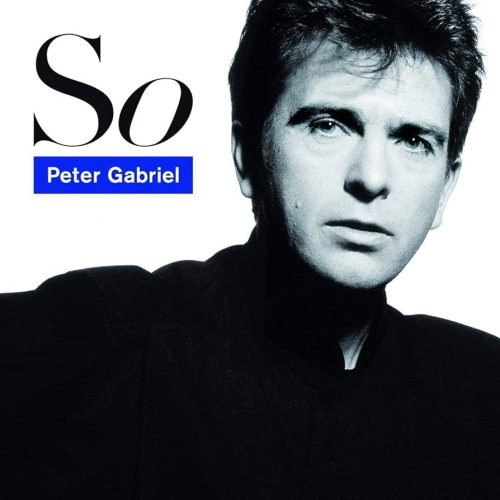In the lush spectrum of the 1980s music scene, Peter Gabriel’s fifth studio album, So, emerges not just as a pivotal point in his career but as a cornerstone in the era’s artistic evolution. Released in 1986, after Gabriel had already severed ties with the progressive rock staples Genesis, So marks a significant departure from the more experimental tones of his earlier solo works. Here, Gabriel moves towards a more accessible pop sound, yet retains the idiosyncratic and avant-garde flair that has always marked his music. This album situates itself at a crossroads where the intricate art rock of Gabriel’s past meets the polished rhythms and melodies suited to the mainstream audience of the time.
Artistic Intentions
Gabriel’s artistic intentions with So were clear—he aimed to craft an album that was both commercially viable and faithful to his artistic integrity. The album strikes a delicate balance, weaving together complex production techniques and diverse musical influences, from the funk-infused beats in “Sledgehammer” to the haunting melodies of “Mercy Street”. In various interviews, Gabriel has expressed that So was an attempt to connect more deeply with listeners, harnessing a more straightforward lyrical style and engaging musical arrangements to make his messages more accessible than ever before.
So thus represents both a deepening and a departure. While it continues to explore themes familiar to Gabriel’s fans—alienation, the mechanization of society, and personal redemption—it does so through songs that are rhythmically robust, lyrically direct, and more resonant with the pop sensibilities of the mid-80s. The album’s nuanced production, courtesy of Daniel Lanois, further helped in sculpting the sonic layers of So, making it not only a critical darling but a commercial success that elevated Gabriel to new heights in the music industry. This blending of artistic ambition with mass appeal underscores Gabriel’s masterful ability to evolve as an artist while influencing the musical landscape around him.
Sonic Exploration

The production quality of So is a testament to the innovative spirit of its era, marrying clarity with complexity in a way that was somewhat ahead of its time. The production, helmed by Daniel Lanois alongside Gabriel, is characterized by its crisp and clear sound, which brings a palpable depth and sharpness to each track. This clarity does not sanitize the album’s emotional grit but rather enhances it, allowing the intricate details of each sonic layer to be appreciated fully. The choice to prioritize high fidelity in the production serves the album’s themes of emotional introspection and social commentary, ensuring that each message delivered is not just heard but felt deeply.
Musical Arrangements
Musically, the arrangements on So are both innovative and memorable. Gabriel’s use of the synthesizer, alongside traditional instruments, creates a rich tapestry of sound that is both futuristic and grounded. One of the standout tracks, “In Your Eyes,” features a stirring mix of lush synthesizers, a compelling percussion section, and soulful backing vocals that elevate the song into a transcendent experience. The vocal arrangement in “Don’t Give Up,” a duet with Kate Bush, utilizes the contrast between Gabriel’s deep, resonant tones and Bush’s ethereal voice to dramatize the song’s themes of despair and hope.
Genre Elements
Genre-wise, So is an eclectic mix that touches upon pop, rock, worldbeat, and funk. This blend is not merely a coexistence of styles but a fusion that gives the album its unique sound. “Sledgehammer,” for example, is heavily influenced by funk and soul, featuring a prominent brass section and playful rhythm that make it irresistibly danceable. Meanwhile, “Mercy Street” delves into the realms of ambient and Brazilian music, with its subdued percussive elements and floating melodies creating a somber, reflective mood. This genre-blending is not just innovative but serves as a bridge, connecting diverse musical traditions and audiences.
Lyrical Analysis

The lyrical content of So navigates through a labyrinth of deeply personal and universal themes, making it a rich field for exploration. Central to the album is the examination of human emotions and relationships, societal reflections, and personal redemption. These themes are not just articulated through the lyrics but are woven into the very fabric of the album’s musical expressions.
One of the recurring motifs in So is the exploration of resilience and vulnerability. In “Don’t Give Up,” for instance, the lyrics portray a narrative of support and hope in times of despair. This message is conveyed through a direct, narrative style, with lines like “Rest your head / You worry too much / It’s going to be alright.” Similarly, “Mercy Street,” inspired by the poet Anne Sexton, delves into themes of seeking solace and understanding in one’s darker moments. Here, the lyrics become more abstract, reflective of Sexton’s introspective and often tormented poetic style, offering lines ripe with imagery: “Looking down on empty streets, all she can see / Are the dreams all made solid / Are the dreams all made real.”
The lyrical depth of So is a blend of straightforward, narrative-driven songwriting and more abstract, evocative imagery. This duality allows the album to reach a wide audience while providing a depth that invites deeper contemplation and interpretation. For example, the hit “Sledgehammer” uses playful and ostensibly simple lyrics to discuss themes of sexual liberation and rejuvenation. Yet, the presentation is interlaced with humor and double entendres, showcasing Gabriel’s skill in embedding complex ideas within accessible lyrical content.
Emotional Impact
Emotionally, the lyrics of So resonate on various levels, often evoking a spectrum of responses from the listener. The emotional impact is significant, with songs like “In Your Eyes,” which conveys a sense of profound love and connection, stirring joy and warmth. In contrast, “Red Rain” captures a mood of ominous foreboding and melancholy, using vivid imagery to evoke a sense of urgency and introspection.
Cohesion & Flow

The coherence of So is not just a function of its production or lyrical depth, but also of the masterful way in which the tracks progress and interconnect, creating a unified narrative and emotional journey. This album exemplifies how track sequencing can enhance the listening experience, guiding the listener through a meticulously crafted emotional and thematic landscape.
Track Progression
Starting with the dynamic “Red Rain,” the album sets a tone of introspection mixed with a sense of urgency, which seamlessly flows into the more upbeat and iconic “Sledgehammer.” This transition cleverly shifts the mood from somber to vibrant, illustrating Gabriel’s range and setting up a contrast that enhances both tracks. The progression from the personal and introspective “Don’t Give Up” into the outward-looking and rhythmic “That Voice Again” shows Gabriel’s ability to oscillate between deeply personal issues and more general contemplations on communication and misunderstanding in relationships.
The flow of the album maintains a balance between variation and consistency, avoiding jarring shifts while still offering enough diversity to keep the listener engaged. The track order appears to follow an emotional crescendo, peaking with “In Your Eyes,” which serves as a culmination of the album’s themes of love, hope, and spiritual connection. This track, placed towards the end, acts almost as a resolution to the narrative and emotional threads woven earlier in the album.
Thematic Consistency
Thematically, So remains consistent even as it explores a variety of topics. The themes of emotional struggle, personal transformation, and the quest for connection are revisited in various forms across the tracks. Stylistically, the album melds elements of rock, pop, and world music, maintaining a sonic signature that is unmistakably Gabriel’s, characterized by his voice, his lyrical sensibilities, and his innovative use of technology and production techniques.
In terms of emotional flow, So is crafted to take listeners on a journey that mirrors the complexities of human experience—through highs and lows, with each track contributing to a broader narrative arc. The album’s ability to move listeners, to make them think, and to feel is a testament to its cohesive structure. Each song not only stands on its own but also contributes to the album as a whole, making So a cohesive, immersive, and enduring work of art.
Standout Tracks & Memorable Moments
So is brimming with tracks that not only showcase Peter Gabriel’s artistic innovation but also underscore his ability to evoke a broad range of emotions. Among the album’s many highlights, a few tracks stand out for their exceptional artistry and emotional depth.
Key Tracks
“Sledgehammer” is perhaps the most commercially recognizable track from the album, celebrated for its funky vibe and groundbreaking music video. What sets this track apart is its blend of brass-heavy, soul-inspired beats with whimsical yet sharp lyrics that play on themes of rejuvenation and desire. The song is a showcase of Gabriel’s clever wordplay and innovative sound, making it a defining track of the 80s.
“Don’t Give Up” stands out as a poignant anthem of perseverance and support. This duet with Kate Bush is particularly moving, with its simple yet powerful arrangement that allows the emotional weight of the lyrics to shine through. The alternating vocals between Gabriel and Bush create a dialogue of encouragement and empathy, resonating deeply with listeners facing their own struggles. The line, “Rest your head / You worry too much,” delivered by Bush, becomes a comforting refrain that many turn to in times of distress.
Memorable Moments
“In Your Eyes” represents another pinnacle of So, notable for its lyrical beauty and the warmth of its composition. The song combines elements of rock and world music, creating a rich, polyrhythmic texture that enhances the song’s themes of love and connection. The moment when the background vocals swell and Gabriel sings, “In your eyes, the light the heat,” is emotionally charged and highlights his ability to craft music that touches the soul.
A particularly memorable moment within the album occurs in “Mercy Street,” where Gabriel pays homage to poet Anne Sexton. The use of soft percussion alongside haunting melodic lines creates a reflective space for listeners. The whispered delivery of lines like, “Looking down on empty streets, all she can see are the dreams made solid,” captures the essence of introspection and vulnerability that pervades the album.
These tracks and moments not only highlight Gabriel’s prowess as a musician and songwriter but also encapsulate the thematic and emotional breadth of So. Each standout track and moment contributes to the album’s lasting impact, marking it as a work of profound artistic expression and emotional depth.
Artistic Contributions & Innovation

Peter Gabriel’s So is not merely an album; it’s a milestone in the evolution of pop and world music genres, underpinning its esteemed place in the music industry. Its release during the mid-1980s, a period rife with musical experimentation and boundary-pushing, saw Gabriel stepping out from the shadows of his progressive rock background with Genesis to cement his status as a solo artist who could not only conform to pop sensibilities but also expand them.
Boundary Pushing and Industry Impact
So breaks from the norms with its sophisticated blend of genres. Gabriel’s integration of world music elements, particularly through the use of African polyrhythms and instruments, set a precedent in the pop music scene. This approach not only broadened the sonic palette of mainstream music but also influenced how other artists viewed the potential of integrating diverse musical traditions into popular music. In doing so, Gabriel helped to pave the way for the worldbeat genre to gain more prominence in Western music.
Moreover, So was instrumental in showcasing the potential of music videos as an art form, particularly with “Sledgehammer.” The video remains one of the most iconic of the era, known for its innovative stop-motion animation. It played a significant role in how music was marketed and consumed in the late 20th century, leveraging MTV’s explosion to reach a global audience. This visual component was crucial in solidifying the album’s impact beyond the auditory experience, marrying sound with visual artistry in a way that was ahead of its time.
Innovation in Production and Thematic Exploration
From a production standpoint, So stands out for its pristine sound quality and the depth of its audio engineering. Working with producer Daniel Lanois, Gabriel crafted an album where every track is sonically distinct yet unified, allowing for a rich auditory experience that rewards repeated listens. The innovative use of gated reverb on drums, which Gabriel had pioneered earlier in his career, and the introduction of digital sampling and synthesis, helped create textures that were fresh and contemporary.
Thematically, Gabriel’s approach to addressing complex emotions and human experiences in So diverges from much of pop music’s often superficial treatment of similar themes. Songs like “Mercy Street” and “Don’t Give Up” explore deep psychological and emotional landscapes with a sensitivity and intelligence that challenge the listener intellectually and emotionally. This depth is a hallmark of Gabriel’s work and contributes significantly to the album’s enduring appeal.
Closing Thoughts

Peter Gabriel’s So stands as a paragon of musical innovation and emotional depth, encapsulating the best of what pop music can offer when it dares to think outside conventional boundaries. The album’s strengths are manifold, from its sonically rich production to its thoughtful lyrical content and genre-blending prowess. The successful fusion of world music with pop and rock elements not only broadened the listeners’ horizons but also set a new standard for artistic exploration in mainstream music. The album’s crisp production, courtesy of Daniel Lanois, ensures that each track delivers a tactile and immersive listening experience, making So a benchmark for audio production.
A particular strength of So is its ability to remain profoundly personal while addressing universal themes—connecting deeply with listeners across different backgrounds and eras. Tracks like “Don’t Give Up” and “In Your Eyes” offer messages of hope and resilience that continue to resonate with audiences, illustrating the timeless quality of Gabriel’s songwriting.
If there are weaknesses in So, they might only be perceived in terms of its sheer ambition. For some, the eclectic mix of sounds and styles could feel overwhelming or divergent from Gabriel’s earlier, more experimental solo work. However, these aspects are also what make the album a standout, demonstrating Gabriel’s ability to evolve artistically and appeal to a broader audience without sacrificing depth or complexity.
Official Rating
Given this analysis, So undoubtedly earns a perfect score of 10 out of 10. This rating is not just for its impeccable production, innovative musical arrangements, and lyrical sophistication but also for its significant impact on the music industry. So is more than just an album; it’s a cultural artifact that pushed the limits of what popular music could achieve in the late 20th century. It has not only influenced a wide array of artists across genres but has also stood the test of time, continuing to be a touchstone for quality and creativity in music.
